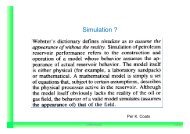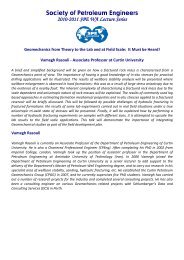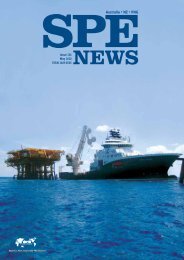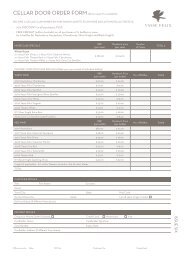Download Issue 131 - January/February 2010 - SPE WA
Download Issue 131 - January/February 2010 - SPE WA
Download Issue 131 - January/February 2010 - SPE WA
- No tags were found...
Create successful ePaper yourself
Turn your PDF publications into a flip-book with our unique Google optimized e-Paper software.
Drilling Aheadvertical alignment. The deep stab and increasedlead reduce the number of turns required toadvance the connection from the stab positionto complete make-up. Tool joint OD and IDdimensions were sized to provide the neededtorsional strength. In this article, pitch refers tothe axial distance from one thread to the nextthread and lead refers to the axial distance thepin is advanced into the box with one revolution.Often pitch and lead are used interchangeably fora single-start thread type. Lead and pitch will bedifferent for a double-start or twin-helix threadtype.HI-TORQUE ® , the fi rst generation premiumrotary-shouldered connection, was developedin the late 1970s. The HI-TORQUE ® connectionincorporated the same thread body parameters(i.e. pitch, pitch diameter, thread form and taper)as similar sized API, NC and FH connections. Thisallowed existing gauges and tooling to be usedin the manufacturing process. An internal torqueshoulder provided approximately 40% additionaltorque capacity and a fl ush ID. Extended pin baseand box counterbore were designed to controlthe division of torque between the internaland external torque shoulder. Compared to APIconnections, the additional torque capacityprovided by the second shoulder allowedfor more fl exible tool joint confi gurations.Confi gurations could target higher operationaltorque, greater OD wear allowance, and/orslimmer connection profile (smaller tool joint OD,larger tool joint ID), depending on the needs of thespecifi c application.The second generation premium rotary-shoulderedconnection, eXtreme ® Torque, was developed inthe mid-1980s. By eliminating the restrictions ofusing the API thread body, the eXtreme ® Torqueconnection further optimised the double-shoulderdesign. Reducing thread height and fl atteningthe taper allowed the torque shoulder areas tobe increased. Further, the thread length could bedesigned to maximise torque shoulder size whilemaintaining the needed thread shear and bearingareas for tensile capacity. The custom thread formfeatured a larger root radius, reducing stress andincreasing fatigue life. Similar to the HI-TORQUE ®connection, the extended pin base and boxcounterbore elements allowed the make-uptorque to be properly proportioned betweenthe internal and external torque shoulders.The eXtreme ® Torque connection provided anapproximate 30–85% increase in torque capacitycompared to API connections depending onsize. This additional torque capacity providedthe same tool joint confi guration fl exibility asthe HI-TORQUE ® connection but to a largerdegree. The greatest benefi t derived from useof the eXtreme ® Torque connection was that itmade possible to switch to the next largest pipesize while maintaining fi shability. It permitted3½” drill pipe to be replaced with 4” drill pipe,greatly increasing hydraulic performance,torque capacity, and drill string stiffness. Withthe development of 5 7 /8” drill pipe, this secondgeneration connection allowed operators toreplace 5½” drill pipe and gain the ability toextend well depths and step-outs.Development of TurboTorque ® ,the third generationrotary-shouldered connectionThe eXtreme ® Torque connection satisfi ed theneeds of the drilling industry for nearly twodecades. As economically viable reservoirshave become more elusive, operators have beenforced to drill deeper wells in deeper water,requiring drill stems with higher torque capacity.Growth of horizontal, ERD and ultra-ERD wellshave required drill stems to deliver higherhydraulic horsepower to drive motors and provideadequate hole cleaning. Finally, as rig day-ratesand other operational costs increase, combinedwith increased well TMD, the drill stem’smake-up speed and related tripping time areever more important. To answer these needs,the industry’s fi rst family of rotary shoulderedconnections was developed in the early 2000s.The development of TurboTorque ® , thethird-generation double-shouldered rotaryconnection, resulted in further refi nement andoptimisation of rotary-shouldered connectiondesign. Typically, the development of newconnections has been targeted and optimisedfor the most popular pipe size, and then thedesign criteria is extrapolated to the other pipesizes. This connection is unique in that it is theindustry’s first rotary-shouldered connectiondesigned to meet the different needs of eachpipe size. As a result of this unique approach,the product line is composed of a family of fourdistinct connection designs, each optimisedto meet specifi c requirements—whether highertorque, improved hydraulics, or speed of make-up.Historically, drill pipe tool joints have beenmade from steel, with a specifi ed minimumyield strength of 120 ksi. TurboTorque ®connections are engineered for use with 130ksi tool joint material. The higher yield strengthand optimisation of the connection’s pitch,taper, thread height and thread length alloweddesigners to provide increased torqued capacitycompared to previous designs. Additionally,the tool joint profi le can be confi gured to meetapplication-specifi c needs such as maximisingthe ID for tool passage and increased hydraulicperformance, providing additional tool joint wearcapacity to extend drill pipe life, or permittingthe running of the next largest pipe size withoutloss of fi shability.Compared to API connections, the eXtreme ®Torque connection’s slow speed of make hadbeen a major disadvantage. To correct thisproblem, the TurboTorque ® connection is theindustry’s fi rst rotary-shouldered design toincorporate a double-start thread (see Figure 1).Double-start threads have been used in casingconnections for decades. Dual threads, 180°apart, form a double helix and reduce the numberof turns to make-up, the connection from stabto shoulder, by 50%. The doubling of the threadlead increases the thread lead angle, providingan increase in the connection’s torque capacityof 12%.The TurboTorque ® connection has had a positiveimpact on rig fl oor operations. Higher tool jointyield strength allowed the optimisation of theconnections taper and thread height to increasestabbing depth, further reducing the number ofSince its release, theTurboTorque connection hasbeen deployed in a number oflocations, including:• Chevron, GOM: 5.875” 26.30# S-135R2 TurboTorque 585• Shell Oil, GOM: 5.875” 23.40# S-135R2 TurboTorque 585• ENI-GOM: 5.875” 26.30# Z-140 R2TurboTorque 585• Shell Oil, GOM: 5.000" 19.50# R2S-135 TurboTorque 526• Shell, GOM: 3.500” 15.50#, S-135 R2TurboTorque 380• Apache, North Sea: 5.500” 21.90#S-135 R2 TurboTorque 550• COR ,Vietnam: 4.000” 14.00# S135T R2TurboTorque 390• Chevron, GOM: 5.875” 26.30# S-135R2 TurboTorque 585• Chevron, Nigeria: 5.500”21.90# S-135TurboTorque 55018 <strong>SPE</strong> NEWS <strong>January</strong>/<strong>February</strong> <strong>2010</strong>www.spe.org










